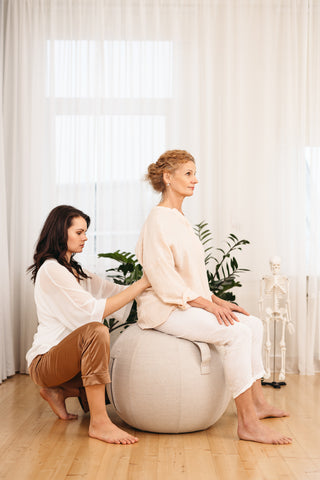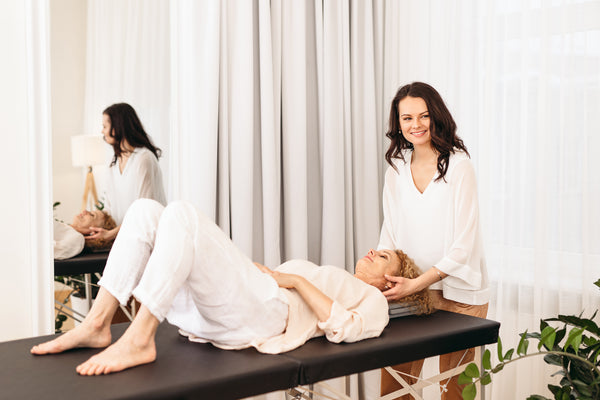On the importance of good posture
The body is our home, not just a machine that takes us to work in the morning and brings us back home in the evening.
Unfortunately, the body is often in a state of unconscious neglect, operating on autopilot and only becoming noticeable when tensions, pains, illnesses, and injuries arise. This lack of connection with and awareness of the body is the root cause of many physical and mental problems.

What problems does poor body usage cause?
- Neck and shoulder tension and pain
- Jaw tension and pain
- Back pain
- Breathing problems
- Tension headaches
- Brain fog
- Joint problems
- Overuse injuries
- Attention and concentration difficulties
- Balance and coordination problems
- Voice problems

What are the causes of poor body usage?
- Lack of body and overall self-awareness
- Sedentary lifestyle
- Anxiety
- Chronic stress
- Chronic fatigue
- Trauma stored in the body
- Suppressed and unprocessed emotions
- Low self-esteem and inner insecurity
- Emotional reactivity
- Loud inner critic
- Low muscle tone
- Excessive muscle tension
Improving body usage enhances both physical and mental well-being.
'If you want to know what kind of thoughts you’ve been thinking for most of your life, look at your posture and movement patterns.' – Ayurveda, traditional Indian medicine.
Posture and movement patterns are closely connected to mood and psychological well-being. In her book Presence, Amy Cuddy highlights: 'When we feel powerless or anxious, we try in almost every way possible to make ourselves smaller. Instead of taking up more space, we take up less – through our posture, gestures, walk, and even voice. We shrink, slump, and constrain our body language.'
Thus, by changing how you habitually use your body, you also change your thoughts, emotions, and, most importantly, the state in which you live.

Benefits of improving body usage:
- Reduced muscle tension and discomfort
- Reduced chronic pain
- Reduced stress and anxiety
- Lower risk of overuse injuries
- Better breathing quality
- Improved circulation
- Improved digestion
- Better balance and coordination
- Improved nervous system functioning
- Enhanced attention and more energy
- Reduced emotional reactivity
- Better self-esteem and increased confidence
- Improved emotional regulation
- Better performance in any daily or professional activity.
3 Steps to Improve Body Usage
Improving body usage requires changing habitual patterns. It’s best to focus on one habit at a time, as the nervous system needs time to adjust to changes. Each habit follows the same steps:
AWARENESS – becoming aware of your body usage habits (e.g., noticing tech neck, slouching, shallow breathing, teeth clenching, etc.). UNDERSTANDING – learning to be kind to your body (learning to observe your body, emotions, and thoughts without judgment, and accepting yourself). CHANGE – retraining body usage habits (step by step, using different techniques that create a sustainable change, improving both mental and physical well-being).

AWARENESS STAGE
Things we are unaware of cannot be changed. Therefore, the first challenge is to start observing your body in everyday activities like sitting, standing, walking, lifting, etc. It is also important to maintain body awareness in professional activities (e.g., playing an instrument, sports, public speaking). Observing yourself with curiosity will give you a lot of information about yourself. People usually begin by noticing asymmetries in the body or identifying over- or under-working muscle groups. They may also become aware of when they hold their breath or breathe shallowly. As body awareness becomes more “on the radar,” deepening self-observation can lead to making connections between thoughts, emotions, and body usage. Learning to “read” your body can help you navigate the world of nervous system regulation. This means that awareness of what’s happening in the body gives you information about your current nervous system state and what you need to do to shift it.
UNDERSTANDING STAGE
Growth begins with acceptance. Unfortunately, most people do not have a very good relationship with their body. It seems that no matter what kind of body a person has, they are still not satisfied with it. One of the cornerstones of healing is cultivating self-empathy. The deeper body awareness goes, the more a person begins to discover about their psyche. Looking into the body, one can see many suppressed emotions, traumas, limiting beliefs, pain, and discomfort. In the Alexander Technique, telling stories (e.g., “this happened to me as a child, and that’s why I am this way”) is not important because the work focuses on the nervous system's state in the present moment. In a way, there is a kind of experience of “stepping aside from oneself,” where the body’s intelligence awakens and begins to guide the body toward homeostasis. In many ways, it’s wonderfully simple!
CHANGE STAGE
Only when we have noticed something within ourselves and accepted it can we take concrete and constructive steps to create change. Often, people jump straight to the change stage, but this approach usually does not lead to lasting results. By changing one habit at a time, we can: reduce muscle tension and discomfort, reduce chronic pain, lower stress and anxiety, reduce the risk of overuse injuries, improve breathing quality, improve circulation, improve digestion, improve balance and coordination, improve nervous system functioning, improve focus and energy levels, boost self-esteem and confidence, improve emotional regulation, and enhance performance in both daily and professional activities.
Vaata järgi ka meie pikem vestlus teemal "Miks on oluline muuta kehahoiaku ja liikumismustreid?"
About the Guest Post Author:
Hanna-Liis Lao is a holistic body and movement specialist as well as an Alexander Technique teacher and trainer. She completed a 4-year, 1600-hour Alexander Technique teacher training between 2016 and 2019, studying in Estonia (Alexander Technique Institute), Italy, and London (London Centre for Alexander Technique and Training). She holds an international STAT diploma (Society of Teachers of the Alexander Technique). In 2017, she graduated from the University of Tartu Viljandi Culture Academy with a degree in traditional music.
Leave a comment
Please note, comments must be approved before they are published